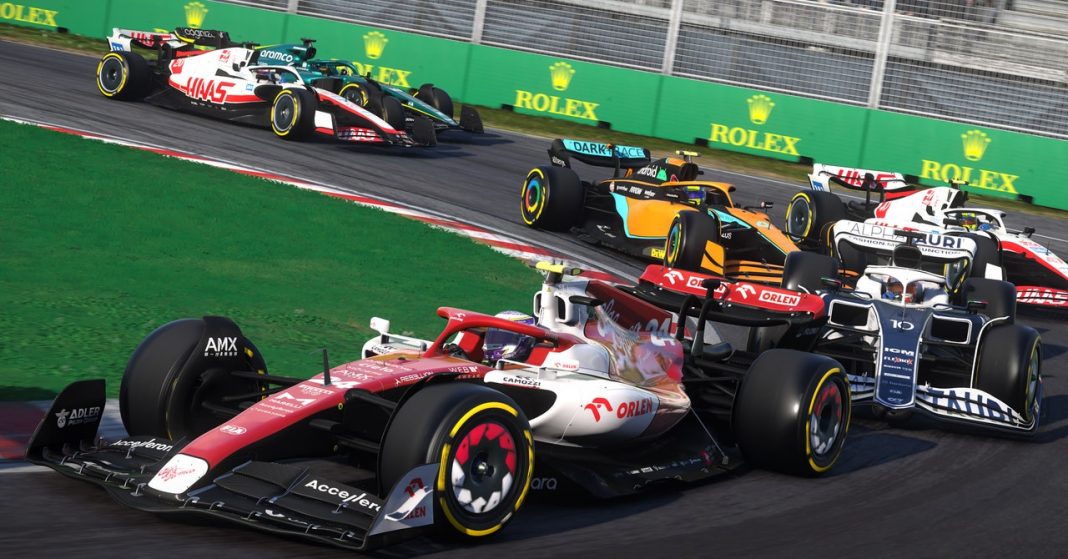The notification flashed up in my peripheral vision as I was barreling through the streets of Baku in a Formula 1 car—past the monuments and minarets of the oil-rich city, Azeri flags and advertising boards whipping by in an artful blur.
“SCToken unlocked,” it read. I did not know what this meant. I’d downloaded F1 22—the latest in a long-running sports simulation game that I’ve been playing on and off for decades—without really looking into its new features, and I assumed this cryptic note had something to do with the blockchain. It doesn’t matter how fast you’re going, I thought, you can’t outrun NFTs.
In fact, the message was my entry into what the game’s developers have called the “F1® Life”—not NFTs, but good old-fashioned unlockables, the kind that can only be bought with gaming prowess or fiat currency (converted, with sickening inevitability, into in-game “PitCoins”). This was initially jarring, but the more I thought about it, the more sense it made—the sport of F1 has always been in thrall to commercial interests, so it’s only natural that its official game would be too.
For my efforts—mainly driving very fast into the scenery—I’d been rewarded with a supercar token, allowing me to unlock a vehicle for my avatar’s virtual showroom. There are eight to choose from—McLarens and Ferraris and Aston Martins in various shades of seizure-inducing neon, the kinds of cars you hear guttering through central London on summer nights or see in YouTube videos taken with a GoPro mounted on a selfie stick and held uncomfortably low. The kinds of cars F1 stars might drive between sponsorship engagements.
The demands of the “F1® Life” are many and varied. A virtual garage begets a virtual apartment—a minimalist box—and a virtual wardrobe. All must be decorated. You can choose from bland soft furnishings and abstract wall art or create a driver in your likeness and dress him in Beats headphones and branded leisure wear. (There are thousands of permutations, but somehow every single one winds up looking like an Instagram crypto influencer on a flight to Dubai, very much the F1 aesthetic.) You can even invite friends and strangers to your virtual pad to coo over your range of officially licensed and branded items—a horrifying vision of what the metaverse will actually be like.
Useless microtransactions and skins are nothing new, but they’re usually stitched to the underlying game with more effort than this. Apart from the ability to drive your supercars on track at limited points during the season—in the Pirelli Hot Laps Challenge!—there are few occasions where your PitCoins will make a material or even visual difference to your gaming experience.
Fans of the series might blame this on developer Codemasters being recently acquired by EA, the undisputed kings of the cash grab. Reviews say it’s the one thing that tarnishes an otherwise solid racing game—one which is visually arresting, rewarding to play, and pulls off the rare feat of being accessible to newcomers without alienating the die-hard fans, thanks to a vast range of customizable difficulty settings and assists. You can switch everything on and be guided gently to victory as if you’re taking a spin round the block, or you can switch everything off and slam into the back of Yuki Tsunoda when you miss your braking point at the first corner—and all options in between.
Arguably, the “F1® Life” merely heightens the accuracy of the simulation. Formula 1 has often owed its popularity as much to the circus around it as to the sport itself. The human element was what made F1 so gripping in the 1970s, with the rivalry between Niki Lauda and James Hunt (as depicted in Rush), and so boring during the four-year dominance of Sebastian Vettel in the 2010s. It’s why the sport has enjoyed a renaissance since the Netflix series Drive to Survive, which brings those personal rivalries to the fore. “F1® Life” sort of captures that, although perhaps not in the way the developers intended—instead of adding a sense of glamor, it gamifies the empty consumerism that surrounds (and funds) the sport.
